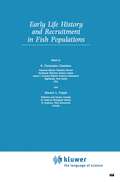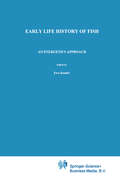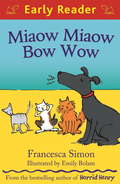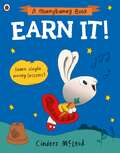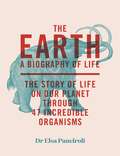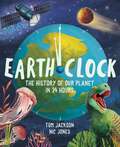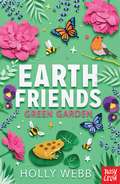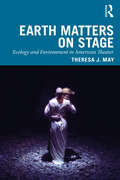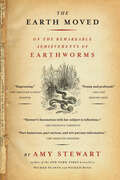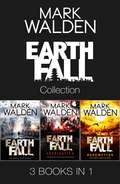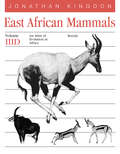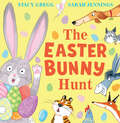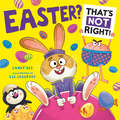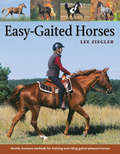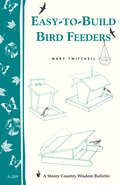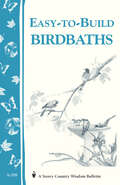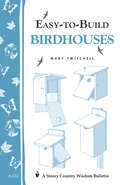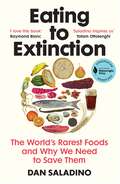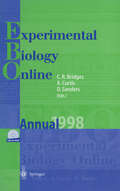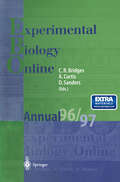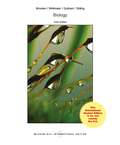- Table View
- List View
Early Life History and Recruitment in Fish Populations (Fish & Fisheries Series #21)
by R. C. Chambers Edward A. TrippelMany of the processes influencing recruitment to an adult fish population or entry into a fishery occur very early in life. The variations in life histories and behaviours of young fish and the selective processes operating on this variation ultimately determine the identities and abundance of survivors. This important volume brings together contributions from many of the world's leading researchers from the field of fish ecology. The book focuses on three major themes of pressing importance in the analysis of the role that the early life history of fishes plays in the number and quality of recruits: the selective processes at play in their early life history; the contributions of early life history to the understanding of recruitment.
Early Life History of Fish: An energetics approach (Fish & Fisheries Series #4)
by E. KamlerAmong the fishes, a remarkably wide range of biological adaptations to diverse habitats has evolved. As well as living in the conventional habitats of lakes, ponds, rivers, rock pools and the open sea, fish have solved the problems of life in deserts, in the deep sea, in the cold Antarctic, and in warm waters of high alkalinity or of low oxygen. Along with these adaptations, we find the most impressive specializations of morphology, physiology and behaviour. For example we can marvel at the high-speed swimming of the marlins, sailfish and warm-blooded tunas, air breathing in catfish and lungfish, parental care in the mouth-brooding cichlids and viviparity in many sharks and toothcarps. Moreover, fish are ofconsiderable importance to the survival ofthe human species in the form of nutritious and delicious food of numerous kinds. Rational exploitation and management of our global stocks of fishes must rely upon a detailed and precise insight of their biology. The Chapman and Hall Fish and Fisheries Series aims to present timely volumes reviewing important aspects of fish biology. Most volumes will be of interest to research workers in biology, zoology, ecology and physiology, but an additional aim is for the books to be accessible to a wide spectrum ofnon specialist readers ranging from undergraduates and postgraduates to those with an interest in industrial and commercial aspects of fish and fisheries.
Early Reader: Four Favourite Stories (Early Reader)
by Francesca SimonEarly Readers are stepping stones from picture books to reading books. A blue Early Reader is perfect for sharing and reading together. A red Early Reader is the next step on your reading journey.Dizzy the dog loves to sing, but the mean old Alley Cats won't let him join their chorus. But what do cats know about singing anyway? It's time to show them just what the dogs can do!
Earn It!: Learn simple money lessons (A Moneybunny Book)
by Cinders McLeodA charming picture book for young children to learn simple facts about earning money.Welcome to Bunnyland, where carrots are money! Bun loves to sing and just wants to be rich and famous. When her mum reminds her that stardom takes time and hard work, Bun realises that she'll need to start earning some carrots to make her dreams come true! It's never too early to teach your little bunny about money! Collect all the books in the Moneybunny series:Give It! (A Moneybunny Book)Save It! (A Moneybunny Book)Spend It! (A Moneybunny Book)
The Earth: A Biography of Life: The Story of Life On Our Planet through 47 Incredible Organisms
by Dr Elsa PanciroliA beautiful and informative history of life on our planet.It is difficult to conceive of the vast scale of the history of life on Earth, from the very first living organisms sparking into life in hydrothermal deep-sea vents to the dizzying diversity of life today. The evolution of life is a sweeping epic of a tale, with twists and turns, surprising heroes and unlikely survivors. The Earth beautifully distils this complex story into a meaningful scale. In taking a closer look at 47 carefully selected organisms over fifteen periods in our planetary history, this book tells the whole story of life on Earth, and the interconnectedness that unites us through our ecosystems and planetary history.Prepare to be confounded by the ingenuity of evolutionary biologies, humbled by our own brief part in this epic history, and disquieted by our disproportionate impact on the world we call home.
Earth Clock: The History of Our Planet in 24 Hours
by Tom JacksonThe entire history of Planet Earth as you've never seen it before, ideal for readers 8+.Our planet has been spinning in the blackness of Space for 4.5 billion years. People have only been around for a tiny part of it. But what happened before we arrived on the scene? Before animals, dinosaurs and even trees? Imagine if we could discover Earth's history in one day...Starting the clock from the formation of the Earth, discover each significant moment in time on the clock, counting down to midnight. Earth Clock covers the most interesting and high-impact moments of our planet's geological history with stunning, detailed illustrations, while charting the evolution of life on Earth, from ancient single-celled organisms to the species we know today, until modern humans appear – at just four seconds to midnight. What will tomorrow bring?
Earth Friends: Green Garden (Earth Friends #3)
by Holly WebbThe third fantastic book in the series about four friends who want to make the world a better place.There's a sad, neglected part of the playground at Poppy's school. She's desperate to win the competition to transform it and she's got some great ideas - a sensory garden, a hedgehog crossing, flowers to attract bees - but then she's accused of copying! Can Poppy clear her name and create the garden of her dreams?A brilliant series about the small changes that make a big difference, with themes of environmentalism and friendship. Written by Holly Webb, bestselling author of the Pet Rescue Adventure series.With cover illustration by Owen Gildersleeve.Look out for the other books in the Earth Friends series: Fair Fashion, River Rescue, Pet ProtectionOriginally published as Poppy's Garden, this edition of the book comes with a brilliant new cover!
Earth Matters on Stage: Ecology and Environment in American Theater (Routledge Studies in Theatre, Ecology, and Performance)
by Theresa J. MayEarth Matters on Stage: Ecology and Environment in American Theater tells the story of how American theater has shaped popular understandings of the environment throughout the twentieth century as it argues for theater’s potential power in the age of climate change. Using cultural and environmental history, seven chapters interrogate key moments in American theater and American environmentalism over the course of the twentieth century in the United States. It focuses, in particular, on how drama has represented environmental injustice and how inequality has become part of the American environmental landscape. As the first book-length ecocritical study of American theater, Earth Matters examines both familiar dramas and lesser-known grassroots plays in an effort to show that theater can be a powerful force for social change from frontier drama of the late nineteenth century to the eco-theater movement. This book argues that theater has always and already been part of the history of environmental ideas and action in the United States. Earth Matters also maps the rise of an ecocritical thought and eco-theater practice – what the author calls ecodramaturgy – showing how theater has informed environmental perceptions and policies. Through key plays and productions, it identifies strategies for artists who want their work to contribute to cultural transformation in the face of climate change.
Earth Matters on Stage: Ecology and Environment in American Theater (Routledge Studies in Theatre, Ecology, and Performance)
by Theresa J. MayEarth Matters on Stage: Ecology and Environment in American Theater tells the story of how American theater has shaped popular understandings of the environment throughout the twentieth century as it argues for theater’s potential power in the age of climate change. Using cultural and environmental history, seven chapters interrogate key moments in American theater and American environmentalism over the course of the twentieth century in the United States. It focuses, in particular, on how drama has represented environmental injustice and how inequality has become part of the American environmental landscape. As the first book-length ecocritical study of American theater, Earth Matters examines both familiar dramas and lesser-known grassroots plays in an effort to show that theater can be a powerful force for social change from frontier drama of the late nineteenth century to the eco-theater movement. This book argues that theater has always and already been part of the history of environmental ideas and action in the United States. Earth Matters also maps the rise of an ecocritical thought and eco-theater practice – what the author calls ecodramaturgy – showing how theater has informed environmental perceptions and policies. Through key plays and productions, it identifies strategies for artists who want their work to contribute to cultural transformation in the face of climate change.
The Earth Moved: On the Remarkable Achievements of Earthworms
by Amy Stewart"You know a book is good when you actually welcome one of those howling days of wind and sleet that makes going out next to impossible." —The New York Times In The Earth Moved, Amy Stewart takes us on a journey through the underground world and introduces us to one of its most amazing denizens. The earthworm may be small, spineless, and blind, but its impact on the ecosystem is profound. It ploughs the soil, fights plant diseases, cleans up pollution, and turns ordinary dirt into fertile land. Who knew? In her witty, offbeat style, Stewart shows that much depends on the actions of the lowly worm. Charles Darwin devoted his last years to the meticulous study of these creatures, praising their remarkable abilities. With the august scientist as her inspiration, Stewart investigates the worm's subterranean realm, talks to oligochaetologists—the unsung heroes of earthworm science—who have devoted their lives to unearthing the complex life beneath our feet, and observes the thousands of worms in her own garden. From the legendary giant Australian worm that stretches to ten feet in length to the modest nightcrawler that wormed its way into the heart of Darwin's last book to the energetic red wigglers in Stewart's compost bin, The Earth Moved gives worms their due and exposes their hidden and extraordinary universe. This book is for all of us who appreciate Mother Nature's creatures, no matter how humble.
Earthfall eBook Bundle: A 3 Book Bundle
by Mark WaldenSam wakes to see strange vessels gathered in the skies around London. As he stares up, people stream past, walking silently towards the enormous ships which emit a persistent noise. Only Sam seems immune to the signal.Six months later, Sam is absolutely alone. In five minutes Sam learns two things: he is not alone; the drone injury should have killed him instantly - yet he is still alive. The battle for earth is about to begin.This eBook bundle includes:EarthfallEarthfall: RetributionEarthfall: Redemption
Earthworm (Large Print)
This is a picture of an earthworm viewed from above. There is a locator dot shown, which will be at the top left of the page when the image is the right way up. Just down the page, there is a silhouette of the worm at approximately real size. At the left, in the middle of the page, is the worm's head. Its long body, made of many segments, curves around to its tail on the right of the page.
Earthworm (UEB Contracted)
This is a picture of an earthworm viewed from above. There is a locator dot shown, which will be at the top left of the page when the image is the right way up. Just down the page, there is a silhouette of the worm at approximately real size. At the left, in the middle of the page, is the worm's head. Its long body, made of many segments, curves around to its tail on the right of the page.
Earthworm (UEB uncontracted)
This is a picture of an earthworm viewed from above. There is a locator dot shown, which will be at the top left of the page when the image is the right way up. Just down the page, there is a silhouette of the worm at approximately real size. At the left, in the middle of the page, is the worm's head. Its long body, made of many segments, curves around to its tail on the right of the page.
East African Mammals: An Atlas of Evolution in Africa, Volume 3, Part D: Bovids (East African Mammals #7)
by Jonathan KingdonKingdon's remarkable seven-volume masterwork on East African mammals concludes with two volumes on the bovids, placing them in a broad comparative, ecological, and evolutionary context. Volume IIIC covers cattle, water buffalo, kudus, elands, dwarf antelopes, duikers, reedbucks, and waterbucks; IIID covers gazelles, impalas, wildebeests, oryxes, sheep, and goats. In addition to the stunning, lifelike drawings that are an integral part of the text, the volumes include a reappraisal of bovid taxonomy and original analyses of the form and function of body shape and size, horn shape, coat pattern, and tooth structure.
The Easter Bunny Hunt
by Stacy GreggKnock-knock! Who’s at the door? Join Cat and Dog as they await the arrival of one special Easter visitor in this hilarious illustrated picture book.
Easter? That’s Not Right!
by Candy BeeIt’s Easter with a twist in this hilarious mix-up of eggs with legs and hot cross BUMS…
Easy-Gaited Horses: Gentle, humane methods for training and riding gaited pleasure horses
by Lee ZieglerEnjoy a comfortable long-distance ride on a well-trained gaited horse and you&’ll be surprised at how easygoing these handsome animals can be. But unique challenges can arise when horse owners more familiar with the standard walk, trot, and canter try to train these complex and multigeared horses to gait correctly. Author Lee Ziegler guides riders through the finer points of developing and maintaining these extra gaits, using humane training methods that stress patience and good horsemanship.
Easy-to-Build Bird Feeders: Storey's Country Wisdom Bulletin A-209 (Storey Country Wisdom Bulletin)
by Mary TwitchellSince 1973, Storey's Country Wisdom Bulletins have offered practical, hands-on instructions designed to help readers master dozens of country living skills quickly and easily. There are now more than 170 titles in this series, and their remarkable popularity reflects the common desire of country and city dwellers alike to cultivate personal independence in everyday life.
Easy-to-Build Birdbaths: Storey's Country Wisdom Bulletin A-208 (Storey Country Wisdom Bulletin)
by Mary TwitchellSince 1973, Storey's Country Wisdom Bulletins have offered practical, hands-on instructions designed to help readers master dozens of country living skills quickly and easily. There are now more than 170 titles in this series, and their remarkable popularity reflects the common desire of country and city dwellers alike to cultivate personal independence in everyday life.
Easy-to-Build Birdhouses: Storey's Country Wisdom Bulletin A-212 (Storey Country Wisdom Bulletin)
by Mary TwitchellSince 1973, Storey's Country Wisdom Bulletins have offered practical, hands-on instructions designed to help readers master dozens of country living skills quickly and easily. There are now more than 170 titles in this series, and their remarkable popularity reflects the common desire of country and city dwellers alike to cultivate personal independence in everyday life.
Eating to Extinction: The World’s Rarest Foods and Why We Need to Save Them
by Dan Saladino'This inspiring and urgent book is one of the few food books that has ever given me goosebumps... A story full of both loss and hope.' BEE WILSON'We all need to pay more attention to what we are (and are no longer) eating. Dan Saladino inspires us to believe that turning the tide is still possible.' YOTAM OTTOLENGHI'I love this book... I wish the whole world could read it' RAYMOND BLANC--------------From a tiny crimson pear in the west of England to great chunks of fermented sheep meat in the Faroe Islands, from pistachios in Syria to flat oysters in Denmark, from a wild honey harvested with the help of birds to an exploding corn that might just hold the key to the future of food - these are just some of the thousands of foods around the world today that are at risk of being lost for ever. In this captivating and wide-ranging book, Dan Saladino spans the globe to uncover the stories of these foods. He meets the pioneering farmers, scientists, cooks, food producers and indigenous communities who are preserving food traditions and fighting for change. All human history is woven through these stories, from the first great migrations to the slave trade to the refugee crisis today. But Eating to Extinction is about so much more than preserving the past. It reveals a world at a crisis point: the future of our planet depends on reclaiming genetic biodiversity before it is too late. Eating to Extinction is an astonishing journey through the past, present and future of food, a love letter to the diversity of global food cultures, and a work of great urgency and hope.
EBO: Experimental Biology Online Annual 1998 (EBO - Experimental Biology Online Annual #1998)
by Christopher R. Bridges Dale Sanders Adam CurtisThough it is a pleasure to write a short foreword to this collection of excellent scientific papers covering a range of biological topics, the rather depressing feature is the small number of papers. All-electronic publishing is developing and your Editors do have great faith in it. One problem for potential authors has been the reluctance of the abstracting journals to pay any attention to electronic journals - perhaps Springer should make a rapid move in this area and start the first all-electronic journal abstracting this type of literature. However, even the paper citation journals are starting to pay attention to the medium. The particular advantages of all-electronic publishing are beginning to emerge more clearly and it is clear that publishing video material is a unique advantage of our format. Several papers took advantage of this - for example those by Riehle and others on cell behaviour in tunnels, by Bereiter-Hahn and Voss on zonation in the plasmalemma and by Pavlikova, Zicha, Chaloupkova and Vesely on cell motility of tumour cells. These papers made essential and extensive use of video material, publishing some material of great originality. The work on cell pola rity and calcium ions in Fucus embryos by Brownlee, Manison and Anning used animation to present their results in an especially clear way. The facility of use of animation is another special advantage of our type of publication that should be more widely used.
EBO — Experimental Biology Online Annual 1996/97 (EBO - Experimental Biology Online Annual #1996/1997)
by Christopher R. Bridges Adam Curtis Dale SandersIn March 1996 the Society of Experimental Biology (UK) together with two other international scientific societies, the Australian and New Zealand Society for Comparative Physiology and Biochemistry and the Society for Integrative and Comparative Biology (formally the American Society for Zoology) joined forces with Springer-Verlag, Heidelberg to produce one of the first fully electronic online, peer-reviewed biological journals, Experimental Biology Online. The present product represents the fruits of this joint venture and encapsulates Volumes 1 and 2 of the journal. This will be an ongoing series such that an archival version of the journal will be available to all libraries as well as the on-line version. At the outset this was "new land" for all concerned but the launching of a journal which would cover experimental biology in terms of Animal, Cell and Plant topics was daunting but we all felt that the use of electronic media and the internet would be ideally suited to this purpose.
